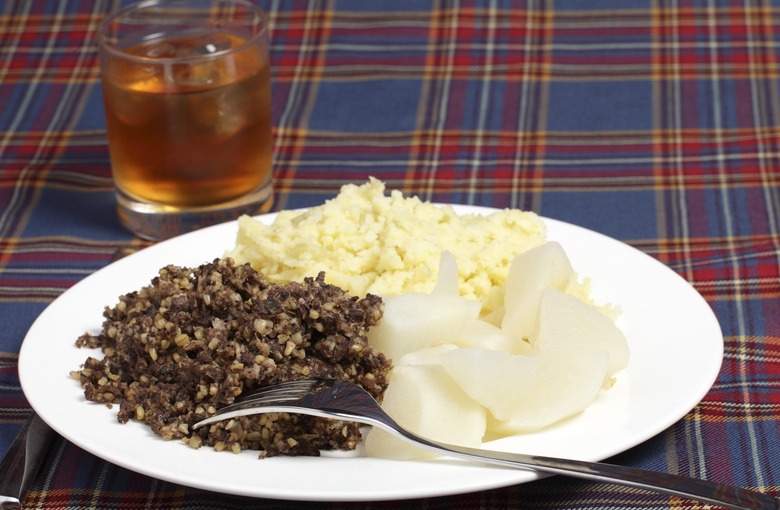Run For Your Life! It's The Dreaded Haggis! The Dreaded Super-Sausage!
The very mention of the definitive Scottish specialty known as haggis tends to induce either gales of laughter or shudders of horror (if not both at once) in the non-Scot. That's because haggis sounds pretty daunting. It's a kind of loose-knit pâté made of minced-up sheep offal (specifically liver, heart, and lungs) mixed with oatmeal, beef suet, and spices, and enclosed, at least traditionally, in the stomach of a sheep.
Admittedly, this sounds rather odd. On the other hand, pork sausage is usually made of finely ground animal parts too, including some that are probably even less appetizing than lungs and heart, and traditionally encased in the animal's intestines — scarcely less appetizing than the stomach (which isn't eaten anyway). The surprising thing is that haggis is really pretty good, sort of like crumbly meatloaf with a lot of flavor.
The derivation of the word haggis is uncertain. The idea that it comes from the French word hachis, hash, doesn't hold up (the Scots word predates the French one), and speculation that it is somehow related to an archaic verb of Scandinavian descent, hag, to cut or hew, does not impress etymologists. The term has been in use (in various spellings) at least since the early fifteenth century, in any case, and the dish was popular not just in Scotland but all over northern England until the 1700s.
Today, with occasional exceptions (Lune Valley Smoke House in Arkholme, in Lancashire, makes "laggis" — Lancashire haggis), haggis is found almost exclusively in Scotland, where it is widely eaten in numerous forms — not just by itself (with the regulation accompaniments of "tatties and neeps," mashed potatoes and mashed rutabaga), but in the shape of croquettes or "bonbons," in savory tarts, in "burger" form, and even, in some of Scotland's Indian restaurants, as a filling for samosas or pakoras. There is also a version made with venison instead of sheep parts, and even a vegetarian one, made with lentils.
Real haggis has been banned from the United States by the USDA since 1971 — the sheep lungs are the issue — but canned haggis, made without the lungs, is available, and a few American butchers make an approved version fresh. The one occasion on which it is guaranteed to show up, in the U.S. and anywhere else Scots gather, is tonight, Burns Night, January 25, celebrating the birth (in 1756) of the great Scottish poet Robert Burns. Burns liked haggis so much that he wrote a poem in its honor, "Address to the Haggis," hailing it as the "great chieftain o' the puddin race" and comparing French and Italian food unfavorably to it.
As F. Marian McNeill rightly points out in The Scots Kitchen, "The haggis is, in fact, simply a super-sausage... and like the sausage, it was once common to many lands." McNeill goes on to cite references to something very much like haggis in "The Clouds" by Aristophanes and in the works of the great Roman gastronome Apicius. "Why everybody except the Scots stopped stuffing the paunch whilst they went on stuffing the intestines," she continues, "the annals of gastronomy do not reveal. And why so many people... regard the haggis as an uncivilized dish and the sausage as a civilized one is another mystery."
